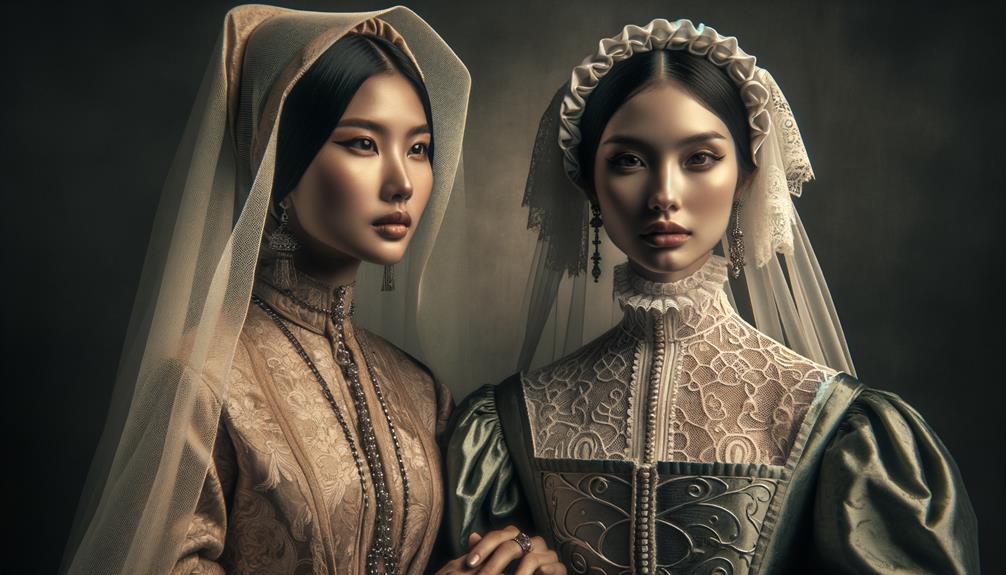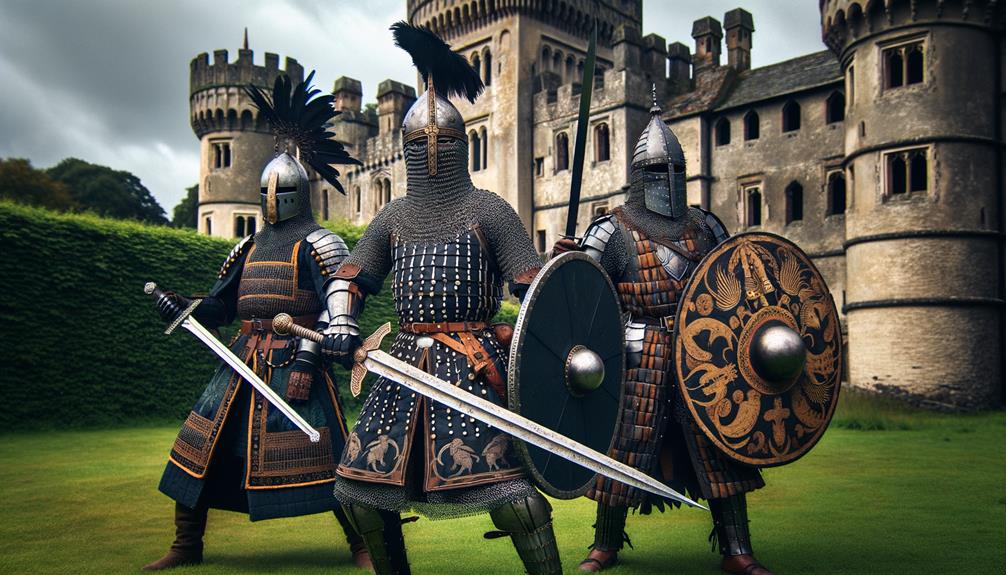The Byzantine Empire's luxurious textiles held a powerful allure for European royalty, shaping the course of medieval fashion. It's fascinating to see how the rich silk and intricate gold embroidery from Byzantium became synonymous with power and status. The elaborate motifs, often inspired by the empire's iconic mosaics, didn't just decorate garments – they conveyed a sense of divine authority. This influence extended beyond the courts, touching clerical attire and even leaving a mark on modern fashion. How did these opulent elements permeate everyday medieval life?
Byzantine Art and Textiles
Byzantine art and textiles had a profound impact on medieval fashion, characterized by intricate designs, rich colors, and luxurious materials. As I delve into the influence of Byzantine art, it becomes clear that the meticulous motifs and patterns derived from iconic mosaics and frescoes made their way into medieval clothing and accessories, setting a new standard for elegance and sophistication.
The textile techniques developed in Byzantium, particularly silk weaving and embroidery, were groundbreaking. I am struck by how these methods transformed the fashion landscape of the medieval period. The precision and artistry involved in Byzantine silk weaving and embroidery made these textiles highly sought after, embodying the pinnacle of craftsmanship.
Furthermore, the opulent Byzantine court dress became a model for medieval nobility's wardrobe. The luxurious and ornate styles worn by Byzantine royalty were emulated by medieval kings and queens, who sought to project power and prestige through their attire. The detailed iconography woven into these textiles wasn't just decorative; it conveyed profound cultural and religious symbolism, further enhancing their allure. Byzantine art and textiles didn't just influence medieval fashion – they redefined it.
Luxurious Materials and Colors
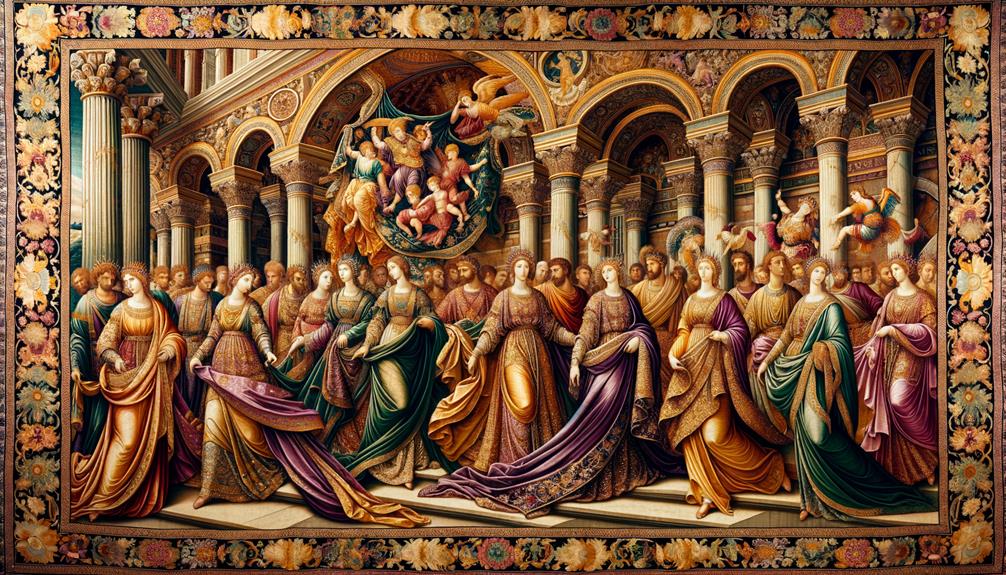
When I think about the impact of Byzantine style on medieval fashion, I'm immediately struck by the opulence of silk fabrics and the vibrant colors achieved through advanced dye techniques. The Byzantines were masters of gold embroidery, creating garments that were truly breathtaking works of art. These luxurious materials and colors defined an era of elegance and grandeur in medieval clothing, showcasing the refined tastes of the time.
Opulent Silk Fabrics
In medieval fashion, richly colored silk fabrics like purple, gold, and red played a pivotal role, reflecting the era's fascination with luxury and status. The opulent garments worn by Byzantine nobility were more than just clothing; they were symbols of power and prestige. Captivated by the luxurious feel, medieval royalty adopted these intricate designs, showcasing their own wealth and influence.
The Byzantine Empire's cultural influence was profound, with silk textiles imported from China becoming a symbol of economic strength. These textiles, with their sumptuous textures and detailed patterns, set the standard for high fashion. To me, the allure of these silk fabrics lay not only in their visual appeal but also in their embodiment of the era's values—power, prestige, and opulence.
Vibrant Dye Techniques
The mastery of vibrant dye techniques, producing deep and rich colors like purple, red, and gold, had a profound impact on medieval fashion's aesthetic. Observing how Byzantine artisans worked with luxurious materials such as silk, I see a clear trajectory of influence. They didn't just dye fabrics; they transformed them into opulent canvases of unparalleled richness.
Byzantine vibrant dye techniques were game-changers, generating colors that spoke of power and prestige. Purple, often reserved for royalty, became a symbol of imperial authority due to the meticulous dyeing processes. Red and gold, equally striking, adorned garments, expressing wealth and status. Medieval fashion eagerly adopted these rich colors, seeking to replicate the Byzantine grandeur.
Furthermore, the intricate patterns that Byzantines incorporated into their textiles demonstrated a sophisticated understanding of aesthetics. These designs weren't merely decorative; they told stories, conveyed cultural significance, and showcased technical prowess. Medieval tailors and dyers, inspired by this opulence, adopted these patterns to elevate their own creations.
In essence, Byzantine dyeing techniques and their lavish use of silk and rich colors set a new standard. They redefined medieval fashion, embedding a legacy of opulence and intricate beauty that continues to inspire today.
Gold Embroidery Mastery
Building on the vibrant dye techniques, the mastery of gold embroidery in Byzantine fashion elevated medieval garments to unprecedented levels of opulence and artistry. Observing the intricate designs and luxurious materials like silk and velvet, it's clear how the Byzantine influence permeated medieval fashion. Gold embroidery wasn't just a decorative technique; it was a status symbol, transforming ordinary cloth into imperial attire.
Reflecting on the opulent designs, it's evident that medieval fashion designers drew inspiration from Byzantine craftsmanship, creating garments adorned with gold thread and luxurious embellishments. The use of such materials didn't just add beauty; it conveyed a message of power and extravagance. The elaborate patterns and shimmering gold threads drew the eye and proclaimed the wearer's elevated status.
Incorporating these elements into medieval fashion wasn't merely about aesthetics. It was about adopting a cultural language of opulence and grandeur. The meticulous gold embroidery techniques, combined with the finest materials, led to garments that were not only visually stunning but also rich in symbolic meaning. This fusion of Byzantine influence with medieval creativity resulted in attire that truly epitomized luxury and imperial splendor.
Influence on European Royalty
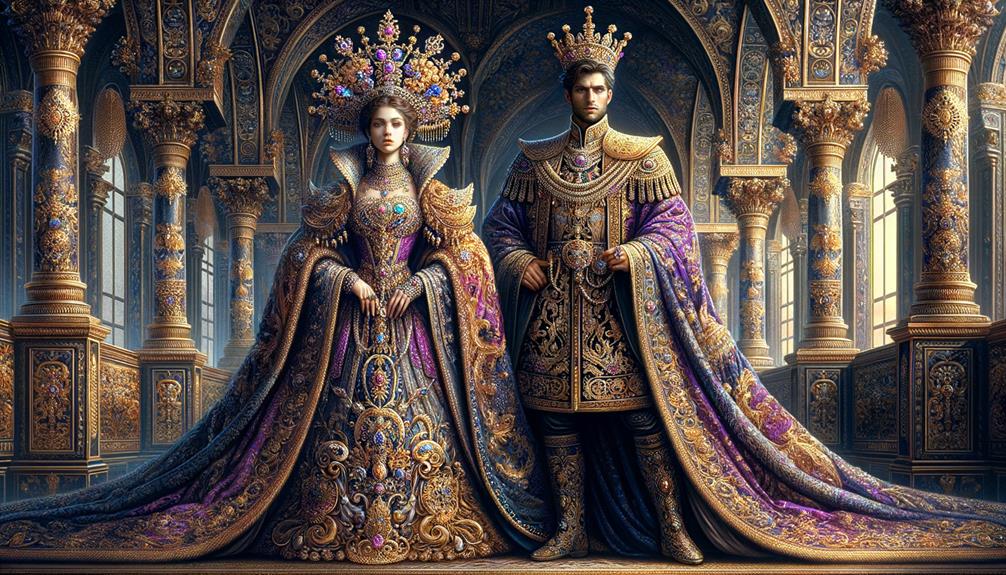
European royalty was captivated by the luxurious textiles and rich colors that Byzantine fashion brought to their courts. The allure of Byzantine opulence, epitomized by Emperor Justinian and Empress Theodora's reign, was irresistible. Their imperial power and regal symbolism were enthusiastically emulated in European court dress, featuring lavish silks and gold embellishments that signified not just wealth but a connection to the sophisticated Eastern Empire.
Several key elements stand out when observing the influence of Byzantine fashion on European royalty:
- Luxurious Textiles: Rich silks and brocades, often imported directly from Byzantium, adorned the garments of European nobility, showcasing their wealth and status.
- The adoption of Byzantine Motifs in royal attire added visual grandeur, featuring ornate patterns and symbols, including religious iconography.
- The use of Regal Symbolism, such as gemstones and gold thread in clothing, mirrored the imperial power of Byzantine rulers, asserting the authority of European monarchs.
- Accessories, including intricate headdresses, jewelry, and other adornments, completed the transformation, making European courts shimmer with Byzantine splendor.
Reflecting on this period, it's clear that Byzantine fashion transformed European royalty, leaving a lasting legacy in the grandeur and elegance of medieval European attire.
Intricate Embroidery Techniques
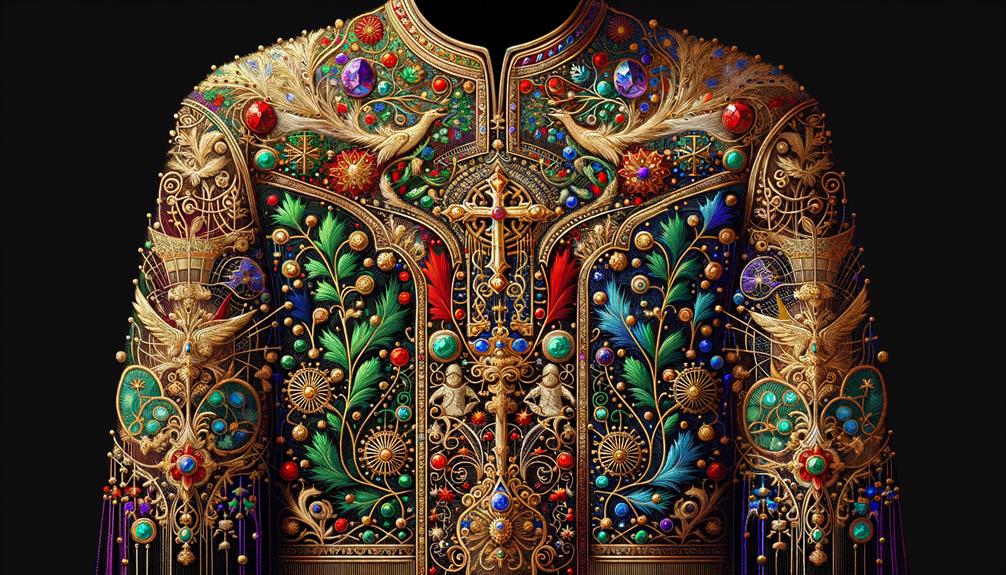
When I examine Byzantine embroidery, I'm struck by the rich gold thread embellishments that defined their artistry. The intricate geometric patterns and religious motifs weren't just decorative; they conveyed deep cultural and spiritual significance. It's fascinating to see how these techniques influenced medieval fashion, adding layers of texture and meaning to clothing.
Gold Thread Embellishments
During the medieval period, Byzantine gold thread embroidery transformed garments into symbols of opulence and sophistication. I've always been fascinated by how these intricate embroidery techniques seamlessly integrated gold thread into medieval clothing, creating opulent designs that were the hallmark of Byzantine craftsmanship. This wasn't just fashion; it was a statement of luxury and power.
To paint a vivid picture:
- Gold Thread: Fine strands of gold were meticulously woven into fabrics, adding a radiant shimmer that illuminated the wearer.
- Embroidery Techniques: Artisans employed various stitches and patterns to create complex and visually stunning designs.
- Opulent Designs: These designs often featured elaborate motifs inspired by Byzantine artistry, making each garment a masterpiece.
- Byzantine Craftsmanship: The skill and precision required for such detailed work were unparalleled, reflecting the grandeur of the Byzantine Empire.
Such embellishments weren't just for anyone; they were primarily reserved for royalty and nobility, who sought to showcase their wealth and status through their attire. The use of gold thread in medieval fashion echoed the splendor of Byzantine textiles, making it a quintessential element of luxury fashion. It's clear that the influence of Byzantine gold thread embroidery was profound, leaving an indelible mark on medieval sartorial elegance.
Geometric Pattern Designs
The intricate geometric pattern designs in medieval embroidery reveal a profound Byzantine influence, showcasing the mastery of artisans who crafted visually stunning textiles. When I examine these patterns, I'm struck by how interlocking circles, squares, and intricate floral motifs add an air of sophistication and luxury to medieval garments. It's fascinating to see how Byzantine-inspired embroidery techniques elevated the textile art form.
Byzantine artisans perfected the art of crafting elaborate geometric patterns, a skill that medieval fashion designers enthusiastically adopted. These designs, often featuring intricate floral motifs, conveyed a sense of opulence and cultural depth. I notice how these motifs seamlessly blend into the textiles, transforming simple fabrics into masterpieces of elegance and detail.
Reflecting on this, it's clear that the meticulous embroidery techniques brought a new level of refinement to medieval fashion. The intricate geometric patterns didn't just adorn clothing; they told stories of influence, craftsmanship, and artistic innovation. This adoption of Byzantine-inspired embroidery in medieval fashion marks a pivotal moment where art and luxury converged, leaving a lasting impression on the aesthetics of the era.
Religious Iconography Motifs
The intricate embroidery techniques of medieval fashion showcased the profound influence of Byzantine art. Delicate craftsmanship brought religious motifs to life on garments, reflecting the deeply symbolic nature of Byzantine art. As I examined these garments, I was struck by the opulence they exuded, thanks to the use of gold and silver threads.
Religious iconography was a cornerstone of these intricate embroideries, featuring:
- Saints – Figures of revered saints were meticulously stitched, each detail capturing their holy aura.
- Angels – Ethereal angels adorned many garments, their wings and halos carefully crafted to convey divine presence.
- Biblical Scenes – Entire narratives from the Bible were often depicted, transforming robes into storytelling canvases.
- Byzantine Art Elements – Characteristics such as gold leaf and elaborate patterns underscored the connection to Byzantine opulence.
These embroideries weren't just decorative; they were a visual language of faith and devotion. The precision and dedication required for such work speak to the cultural and spiritual significance of these garments. Observing these pieces, I see not just fashion, but a rich tapestry of history, art, and religion intertwined. The Byzantine influence truly elevated medieval fashion into a unique sphere of sacred artistry.
Iconographic Dress and Symbols
In Byzantine art, iconographic dress frequently featured figures adorned in pseudo-Biblical attire, reflecting both religious reverence and contemporary fashion. The Virgin Mary was often depicted wearing a distinctive mantle with a hood, blending Byzantine clothing with a divine aura.
What fascinates me is how Biblical scenes often featured figures in contemporary Byzantine clothing, seamlessly bridging the sacred and the secular. The clerical dress, evolving from lay clothing into distinct garments like the epitrachelion and orarion, added layers of meaning to these representations. Predominant white or muted colors symbolized purity and spiritual significance.
This intertwining of fashion and faith didn't just stop at the clergy. The symbolism embedded in these garments influenced broader medieval fashion trends, infusing everyday attire with a touch of the divine. By observing these iconographic details, we can see that Byzantine art and clothing were more than just aesthetic choices – they were a powerful medium for conveying religious narratives and values. This fusion of faith and fashion continues to inspire modern innovations in religious and secular attire.
Elite and Clerical Fashion
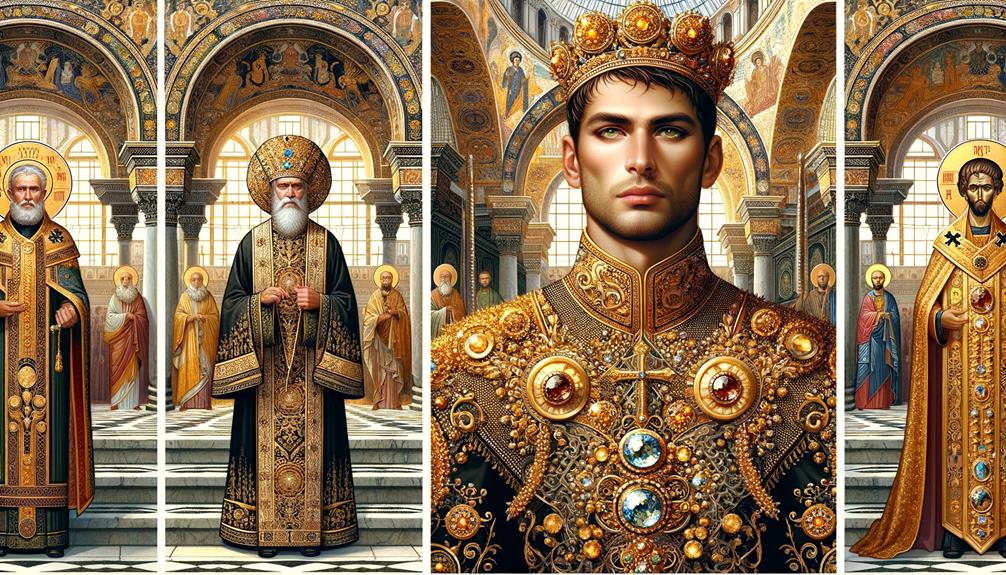
In medieval Byzantium, elite and clerical fashion was a fascinating blend of opulence and symbolism. The Byzantine Empire's elite fashion was a testament to their social status and wealth. Richly patterned silk cloths were commonplace, designed to denote class and rank. For the clergy, distinct garments evolved from lay clothing to specialized attire reflecting their ecclesiastical roles.
I was struck by the meticulous details in their clothing choices:
The chiton robe, a long, flowing garment, was a staple for both elite and clergy, often adorned with intricate patterns and embroidery.
The diadem, a jeweled crown, signified nobility and was worn by both emperors and high-ranking clerics.
Imperial boots, crafted from the finest materials, were a symbol of power and prestige.
Clergy often appeared in pseudo-Biblical dress, complete with shaped mantles and hoods, reminiscent of Biblical times.
Reflecting on Byzantine art, it's clear how these styles permeated even religious iconography. Figures in Biblical scenes donned contemporary Byzantine clothing, bridging the past with their present. This intersection of fashion and symbolism in the Byzantine Empire offers a rich tapestry of innovation and tradition.
Legacy in Modern Fashion
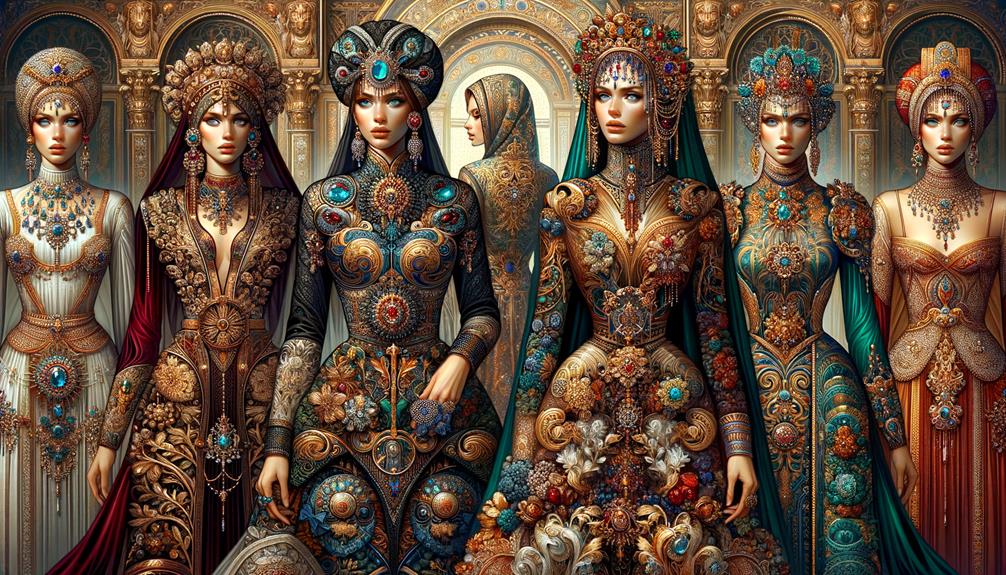
Modern fashion often reinterprets the grandeur of Byzantine clothing, with its penchant for opulence and intricate design. Designers like Alexander McQueen, Chanel, Dolce & Gabbana, and Valentino draw heavily from Byzantine art, incorporating elements like gold, rich colors, and intricate embroidery into their collections. This blend of historical opulence and contemporary style creates pieces that are both timeless and innovative.
What stands out is how these designers incorporate mosaic-like patterns and head-to-toe Byzantine-inspired looks. High-fashion collections often feature stunning jewelry that echoes the Byzantine era's grandeur. Iconic pieces by designers such as Fulco Santostefano della Cerda and brands like Verdura and Givenchy showcase these intricate, historically inspired elements.
The legacy of Byzantine fashion goes beyond merely borrowing aesthetic elements; it's about capturing a sense of splendor and artistry that continues to resonate. Modern fashion is richer for it, proving that the intricate beauty of Byzantine art and clothing remains a wellspring of inspiration, bridging centuries with elegance and flair.
Frequently Asked Questions
What Fashion Designers Were Influenced by the Byzantine Empire?
Like a golden thread weaving through time, it's clear that designers such as Alexander McQueen, Karl Lagerfeld, Dolce & Gabbana, and Valentino have all drawn inspiration from the Byzantine Empire's lavish style and intricate details.
How Did the Byzantine Empire Influence European Styles?
Here's the rewritten text:
Byzantine influence is evident in European styles through the adoption of rich colors, gold embellishments, and luxurious textiles. These elements transformed European fashion, adding a sense of opulence and grandeur that was previously unseen.
What Role Did the Byzantine Empire Play in the Middle Ages?
I see the Byzantine Empire as a cultural and economic powerhouse in the Middle Ages. It played a pivotal role in shaping trade routes, influencing art and architecture, and setting standards in various domains, leaving a lasting legacy that still inspires innovation today.
What Are the Two Major Influences on the Byzantine Style?
Byzantine style is a unique blend of classical Greek modesty and vibrant Persian colors and patterns. These influences merged, creating a distinctive fashion that resonated throughout medieval European attire.



